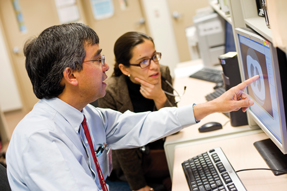Indian Health Service reaches across borders within the U.S.
A partnership allows staff at Brigham and Women's Hospital in Boston to collaborate with physicians who serve Navajo Nation, a medically underserved population in New Mexico.
Members of the Navajo Nation, the largest Native American tribe in the U.S., live in a vast, rural area that spans Utah, Arizona and New Mexico. Many of the approximately 225,000 members don't have plumbing or telephone access. Delivery of everyday health services is challenging, and specialty services even more so.
Native American populations are among the most underserved in the U.S. Their life expectancy is five years shorter than the general U.S. population. In addition, they have high rates of type 2 diabetes, cardiovascular disease, substance abuse, tuberculosis and accidents.

In New Mexico, limited access to care means that chronic conditions may go untreated. Many of the conditions, although not life-threatening at first, progress to a stage where they are challenging for a primary care physician to manage alone. However, subspecialists are usually in short supply.
“Most patients [have] to travel about 3.5 hours to Albuquerque to see a subspecialist, if they can afford it,” said Kimberly Mohs, MD, who first worked with the Indian Health Service (IHS) as part of a scholarship program in medical school and is now the chair of internal medicine at the Northern Navajo Medical Center at Shiprock.
The IHS, an agency of the Department of Health and Human Services, is the main provider of health services to members of federally recognized Native American tribes. In 2008, two IHS hospitals in Gallup and Shiprock, N.M., partnered with Brigham and Women's Hospital in Boston to help improve the Navajo Nation's access to specialty services.
The partnership began as Brigham and Women's Hospital sought to develop a hospital-wide volunteer program that would allow physicians from a variety of specialty areas to get involved in a unified effort.
“What we do at Brigham and Women's Hospital is try to fill that gap or void in access to specialty care,” said ACP Member Thomas Sequist, MD, MPH, associate professor of medicine and health care policy at Harvard Medical School and medical director of the Brigham and Women's Outreach Program.
During the first two years of the program, 50 clinicians visited New Mexico, providing more than 1,000 clinical hours and 800 teaching hours. Volunteers have increased access and education in the fields of endocrinology, dermatology, rheumatology, orthopedic care and others, helping local physicians expand their health care offerings.
“We knew that primary care physicians in the IHS reported high rates of discomfort with the level of complexity of care that they have to manage on their own without specialty input,” Dr. Sequist said. “Our volunteer doctors travel to New Mexico for a week at a time, providing a combination of direct patient care and also lecturing and skills training of the IHS primary care physicians.”
Staying up to date
“The volunteers serve a great role in helping us stay up to date with current medicine,” said ACP Member Maricruz Merino, MD, a physician at Gallup, who first visited IHS during a rotation as a medical resident at Brigham and Women's Hospital. “In Boston, I was frequently rubbing elbows with specialists on the cutting edge of research. Here, that is more difficult. Through this program, these renowned professionals bring their skills to us.”
Volunteers that have participated in the partnership have been specialists in a wide variety of areas.
“In some situations it is specialty services that patients can't get anywhere else,” Dr. Mohs said. “In other situations, it is providing people with those specialty services here so that they don't have to travel.”
Currently, two endocrinologists from Brigham and Women's Hospital have committed to coming to Gallup every year, one every six months, to devise standards and protocols and improve the quality of diabetes care.
“We have a disproportionate amount of diabetes among our patient population,” said Jonathan Iralu, MD, FACP, an infectious disease physician based in Gallup who also trained at Brigham and Women's Hospital. “These volunteers have helped us to develop diabetes treatment protocols, something that we would not have been able to come up with on our own. They are making us more effective and efficient.” Dr. Iralu originally intended to work with IHS for only a two-year rotation and has since devoted the last 17 years of his career to the program.
A group of volunteers with perinatal knowledge, including an obstetrician and nurse, also spent time at Shiprock and conducted multidisciplinary training with the staff there. One obstetrics/gynecology volunteer with specialty knowledge in performing laparoscopic hysterectomies visited and began training the local physicians to become more adept at this procedure.
“Some of our volunteers, in addition to teaching, especially in dermatology and rheumatology, come and provide clinics and see patients because those services are very difficult for us to provide locally,” Dr. Merino said. “When we have dermatologists visit, our clinics are packed. They have made a difference in the lives of individual patients, but they have also been able to work with the pharmacy and therapeutics committee to help change our formularies and help us provide this care on our own in the future.”
Two-way street
Full-time physicians from Gallup and Shiprock are also invited up to Brigham and Women's Hospital on occasion to learn about new skills or be exposed to different health conditions.
“Sometimes there are conditions that are sufficiently rare that the doctors in New Mexico do not have sufficient clinical cases to learn with,” Dr. Sequist said. “However, that doesn't mean that the doctors at IHS don't still see those conditions occasionally. They need to remain comfortable with treating these uncommon but important conditions.”
A classic example, Dr. Sequist said, is a patient who needs to be intubated and placed on a ventilator, a skill that is not needed every day but is crucial when necessary.
“Brigham and Women's Hospital always has multiple intubated patients on any given day in the intensive care units,” Dr. Sequist said. “We provide an opportunity for an IHS doctor to come spend a week with us at Brigham and Women's Hospital and get a lot of experience with a specific skill, and bring that knowledge back to IHS.”
Despite the ever-growing success of the volunteer program, the physicians involved recognized that continued access to specialty care support was needed. The hospitals at Gallup and Shiprock recently began a telemedicine program with Brigham and Women's Hospital. During monthly video conferences, specialists in Boston conduct clinical teaching or case presentations in challenging clinical areas such as cardiology, rheumatology, dermatology or neonatology.
“Usually the specialist physicians from Brigham and Women's Hospital participating in the video conference have traveled out to Gallup or Shiprock and worked on-site with the primary care physicians,” Dr. Sequist said. “That foundational relationship is important because when they make recommendations from 2,000 miles away they understand the conditions of delivering care on the Navajo reservation.”
The physicians involved with Brigham and Women's Hospital and IHS are beginning to try to measure the effect of the program on the knowledge of the local clinicians. For example, Dr. Merino and a colleague are studying insulin prescribing patterns within Gallup.
“We looked at physician prescribing patterns over a four-month period, and then we had an intervention where an endocrinologist came from Boston and lectured about insulin protocols to all levels of staff,” Dr. Merino said. “Soon we hope to evaluate whether that intervention had any effect on whether physicians prescribing patterns changed.”
However, all research is in very early stages of development. Instead, the focus of the partnership remains providing the local people with increased access to quality health care.
Overall, participants said, the partnership allows a mutually beneficial relationship among the doctors in Boston, those in New Mexico, and the people of the Navajo Nation. Although being a jack-of-all-trades can be challenging, the doctors located full-time at Gallup and Shiprock said it can also be incredibly rewarding professionally and personally.
“As a new physician, I wanted to experience the job of a general internist in the truest sense of the word. I wanted to be challenged by the hard cases,” Dr. Merino said. “The downside, of course, is that medicine is very broad and constantly changing. Having this connection with Brigham and Women's Hospital ensures that we continue to provide up-to-date care, even though we are geographically very far from academia.”





